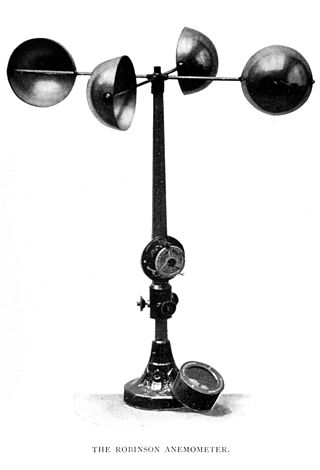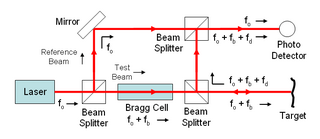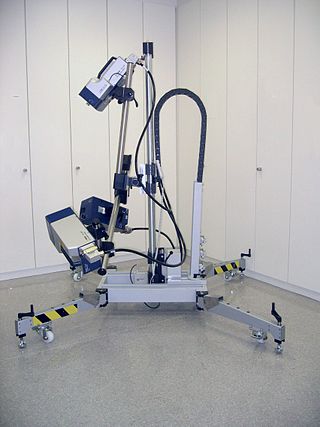
In meteorology, an anemometer is a device that measures wind speed and direction. It is a common instrument used in weather stations. The earliest known description of an anemometer was by Italian architect and author Leon Battista Alberti (1404–1472) in 1450.
The Doppler effect is the change in the frequency of a wave in relation to an observer who is moving relative to the source of the wave. The Doppler effect is named after the physicist Christian Doppler, who described the phenomenon in 1842. A common example of Doppler shift is the change of pitch heard when a vehicle sounding a horn approaches and recedes from an observer. Compared to the emitted frequency, the received frequency is higher during the approach, identical at the instant of passing by, and lower during the recession.
Flow measurement is the quantification of bulk fluid movement. Flow can be measured using devices called flowmeters in various ways. The common types of flowmeters with industrial applications are listed below:

Time of flight (ToF) is the measurement of the time taken by an object, particle or wave to travel a distance through a medium. This information can then be used to measure velocity or path length, or as a way to learn about the particle or medium's properties. The traveling object may be detected directly or indirectly. Time of flight technology has found valuable applications in the monitoring and characterization of material and biomaterials, hydrogels included.
Particle image velocimetry (PIV) is an optical method of flow visualization used in education and research. It is used to obtain instantaneous velocity measurements and related properties in fluids. The fluid is seeded with tracer particles which, for sufficiently small particles, are assumed to faithfully follow the flow dynamics. The fluid with entrained particles is illuminated so that particles are visible. The motion of the seeding particles is used to calculate speed and direction of the flow being studied.

Velocimetry is the measurement of the velocity of fluids. This is a task often taken for granted, and involves far more complex processes than one might expect. It is often used to solve fluid dynamics problems, study fluid networks, in industrial and process control applications, as well as in the creation of new kinds of fluid flow sensors. Methods of velocimetry include particle image velocimetry and particle tracking velocimetry, Molecular tagging velocimetry, laser-based interferometry, ultrasonic Doppler methods, Doppler sensors, and new signal processing methodologies.

Molecular tagging velocimetry (MTV) is a specific form of flow velocimetry, a technique for determining the velocity of currents in fluids such as air and water. In its simplest form, a single "write" laser beam is shot once through the sample space. Along its path an optically induced chemical process is initiated, resulting in the creation of a new chemical species or in changing the internal energy state of an existing one, so that the molecules struck by the laser beam can be distinguished from the rest of the fluid. Such molecules are said to be "tagged".

Particle tracking velocimetry (PTV) is a velocimetry method i.e. a technique to measure velocities and trajectories of moving objects. In fluid mechanics research these objects are neutrally buoyant particles that are suspended in fluid flow. As the name suggests, individual particles are tracked, so this technique is a Lagrangian approach, in contrast to particle image velocimetry (PIV), which is an Eulerian method that measures the velocity of the fluid as it passes the observation point, that is fixed in space. There are two experimental PTV methods:
Holographic interferometry (HI) is a technique which enables the measurements of static and dynamic displacements of objects with optically rough surfaces at optical interferometric precision. These measurements can be applied to stress, strain and vibration analysis, as well as to non-destructive testing and radiation dosimetry. It can also be used to detect optical path length variations in transparent media, which enables, for example, fluid flow to be visualised and analyzed. It can also be used to generate contours representing the form of the surface.
Planar Doppler Velocimetry (PDV), also referred to as Doppler Global Velocimetry (DGV), determines flow velocity across a plane by measuring the Doppler shift in frequency of light scattered by particles contained in the flow. The Doppler shift, Δfd, is related to the fluid velocity. The relatively small frequency shift is discriminated using an atomic or molecular vapor filter. This approach is conceptually similar to what is now known as Filtered Rayleigh Scattering.

Seeding is a fundamental technique in fluid dynamics. It is used to visualize and measure fluid flow. Researchers introduce small particles, called seed particles, into a fluid. These particles move with the fluid. This allows researchers to observe and analyze the fluid's movement under different conditions.
An engine test stand is a facility used to develop, characterize and test engines. The facility, often offered as a product to automotive OEMs, allows engine operation in different operating regimes and offers measurement of several physical variables associated with the engine operation.
Electrophoretic light scattering is based on dynamic light scattering. The frequency shift or phase shift of an incident laser beam depends on the dispersed particles mobility. With dynamic light scattering, Brownian motion causes particle motion. With electrophoretic light scattering, oscillating electric field performs this function.

A laser Doppler vibrometer (LDV) is a scientific instrument that is used to make non-contact vibration measurements of a surface. The laser beam from the LDV is directed at the surface of interest, and the vibration amplitude and frequency are extracted from the Doppler shift of the reflected laser beam frequency due to the motion of the surface. The output of an LDV is generally a continuous analog voltage that is directly proportional to the target velocity component along the direction of the laser beam.
Photon Doppler velocimetry (PDV) is a one-dimensional Fourier transform analysis of a heterodyne laser interferometry, used in the shock physics community to measure velocities in dynamic experiments with high temporal precision. PDV was developed at Lawrence Livermore National Laboratory by Oliver Strand. In recent years PDV has achieved popularity in the shock physics community as an adjunct or replacement for velocity interferometer system for any reflector (VISAR), another time-resolved velocity interferometry system. Modern data acquisition technology and off-the-shelf optical telecommunications devices now enable the assembly of PDV systems within reasonable budgets.

Continuous-scan laser Doppler vibrometry (CSLDV) is a method of using a laser Doppler vibrometer (LDV) in which the laser beam is swept across the surface of a test subject to capture the motion of a surface at many points simultaneously. This is different from scanning laser vibrometry (SLDV) in which the laser beam is kept at a fixed point during each measurement and quickly moved to a new position before acquiring the next measurement.
A laser surface velocimeter (LSV) is a non-contact optical speed sensor measuring velocity and length on moving surfaces. Laser surface velocimeters use the laser Doppler principle to evaluate the laser light scattered back from a moving object. They are widely used for process and quality control in industrial production processes.

Laser Doppler imaging (LDI) is an imaging method that uses a laser beam to image live tissue. When the laser light reaches the tissue, the moving blood cells generate Doppler components in the reflected (backscattered) light. The light that comes back is detected using a photodiode that converts it into an electrical signal. Then the signal is processed to calculate a signal that is proportional to the tissue perfusion in the imaged area. When the process is completed, the signal is processed to generate an image that shows the perfusion on a screen.

The scanning laser vibrometer or scanning laser Doppler vibrometer, was first developed by the British loudspeaker company, Celestion, around 1979, further developed in the 1980s, and commercially introduced by Ometron, Ltd around 1986. It is an instrument for rapid non-contact measurement and imaging of vibration.









